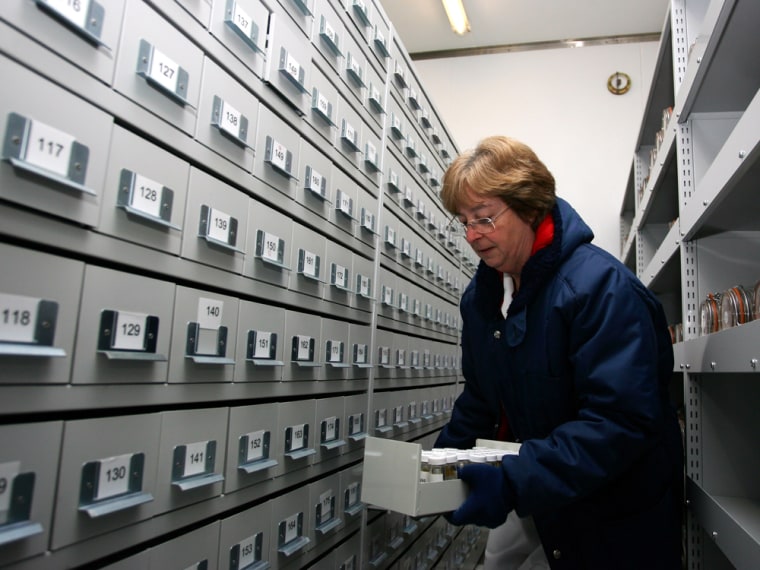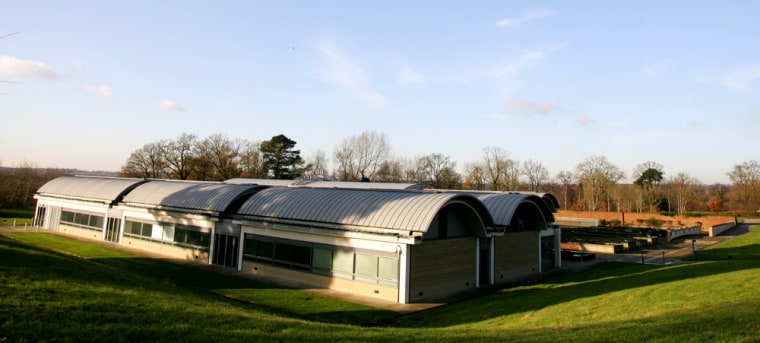The underground bunker can block nuclear fallout, withstand a direct hit by a jetliner, and is cooled to a deathly chill.
The ultramodern facility in the tranquil English countryside looks like a perfect lab for a James Bond villain, but it doesn't hide anything sinister. The only thing kept here are seeds, lots of them — more than a billion, in fact.
Scientists say this is the world's most diverse seed bank, but its keepers worry that the global financial crisis could cut its government and corporate funding and cause the seed gathering to wither at the end of next year, well short of its goal.
"This is the world's biodiversity hot spot," said Paul Smith, director of the Millennium Seed Bank Project, standing outside two room-size vaults filled with precious seeds which are kept at minus 4 degrees Fahrenheit to slow their metabolism.
"That's important for mankind. But if the funding situation doesn't improve, we'll have to stop collecting."
He has already seen a tightening of philanthropic budgets in recent months that is affecting the seed bank's future. "We have not raised the kind of money we had hoped to at this point," Smith said.
Focused on wild species
There are more than 1,000 seed banks — including a newly opened, unmanned "doomsday" facility in the Arctic wastes of Norway that will ultimately house more than 1 billion crop seeds. But the one at Wakehurst Place, about 30 miles south of London, says it's the only global facility of its kind, unique for its focus on wild species, not just crops.
It says it aims to store a quarter of the world's species by 2020, and could eventually house half of them. It currently has 25,000 species and 1.5 billion seeds.

The seed bank's scientists gauge the total number of plant species at 300,000, which represents a middle figure in the widely varying, constantly changing, global estimate.
It doesn't just take in seeds — it sends them out. Millennium Bank seeds are being used in Australia to figure out what plants can grow in salty reclaimed land, and in Pakistan and Egypt to find plants that can withstand drought and slow desert encroachment.
The bank is helping to restore tall prairie grass in the United States and a tropical forest in Madagascar.
Saving the world's seeds does not come cheap.
A global effort
At the Millennium Seed Bank, it costs about $3,000 per species to ship in the seeds, meticulously clean them, X-ray them for insect damage and freeze them for possible future use as medicine, a commercial product, or a reviver of a plant that has gone extinct.
It is a global effort: The bank has more than 120 different partners in some 50 countries where seeds are collected and stored. In many cases, seeds are kept both in their native countries and here as a backup.
Some countries, Brazil for instance, are unwilling to send precious seeds overseas, so they are kept in at least two seed banks inside the country, their standards monitored by Millennium Seed Bank experts.
The project, under the Royal Botanical Gardens at Kew, started in 2000 with 72 million pounds, then about $110 million, in funding from Britain's national lottery and governmental, corporate and individual sponsors.
Smith said the seed bank needs to raise about 10 million pounds ($15 million) a year for the next decade.
Largest seed is the size of two coconuts
The futuristic facility, with its low-slung steel and glass structure over the vaults, is seen by scientists as an insurance policy against nature and human folly. It is a quiet place, where young scientists in white smocks spend hours cleaning seeds by hand, using microscopes, scalpels, forceps, and tiny brushes. The largest is the double coconut seed, almost as big as two coconuts; smallest is the Venus looking glass — with more than a million seeds fitting into a small canister.
Before depositing the seeds in the vaults, lab workers don floor-length parkas.
Even then, the temperature is so low that bodies start losing core heat in 15 minutes. So elaborate safety systems are in place in case anyone is trapped in a vault; an AP photographer inadvertently tripped a series of ringing alarms when he left the vault while a worker remained inside.
Invaluable as climate change accelerates
Scientists call the Millennium effort invaluable as climate change accelerates.
"The potential value of this project is almost unfathomable," said David Astley, head of the Genetics Resources Unit at the University of Warwick in England, who corroborated the Millennium Projects claim to be the world's most diverse seed bank.
"If you look at the way the world is going, it's inevitable that genetic material will be lost," said Astley, who is not connected to the project. "The big fear is that, if global warming comes sooner rather than later, it may be too late to conserve the material."
Scientists here are also developing new ways to germinate endangered species, including some like the South African faucaria that are down to a single population of plants in the wild.
"We don't know that they are useful for anything," Smith said, "but we don't know that they aren't useful either."
Possible medical use
The same could be said of the roughly 80 percent of species here that have not yet been screened for possible medical use.
"Twenty years ago we didn't know the rosy periwinkle from Madagascar would reduce childhood leukemia to the extent that it has," said Smith.
"So who knows what we have in the bank? Our worry is that we're going to lose those in the wild before we even have a chance. So putting them in the seed bank is the most logical first step."
Already, a handful of species collected here have vanished in the wild as habitat is destroyed. Scientists believe these could be reintroduced in the next few centuries. Some seeds, they believe, may last one thousand years under ideal conditions.
Researchers here have already been able to germinate seeds that are more than 200 years old, bringing to life a "pin cushion flower" — known as the leucospermum — from seeds dating back to 1803.
The seeds tell the story of lost empire — they were first collected by a Dutch merchant trading in South Africa, but he was intercepted on his return voyage by a British privateer because Britain was at war with the Dutch at the time.
The seeds were taken from the Dutchman, who was imprisoned in the Tower of London, and were eventually discovered in the National Archives and given to the seed bank.
Scientists expected germination attempts to fail, but were pleasantly surprised when they were able to grow the flowering plant at the Millennium Seed Bank, where it can sometimes be seen in the greenhouse.
They take this as a hopeful sign that other seeds can lay dormant for hundreds of years and be brought back to life.
